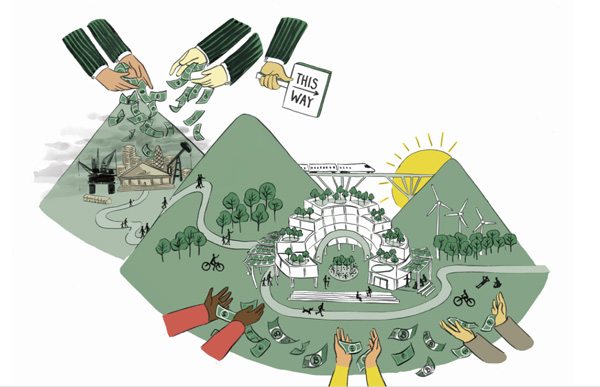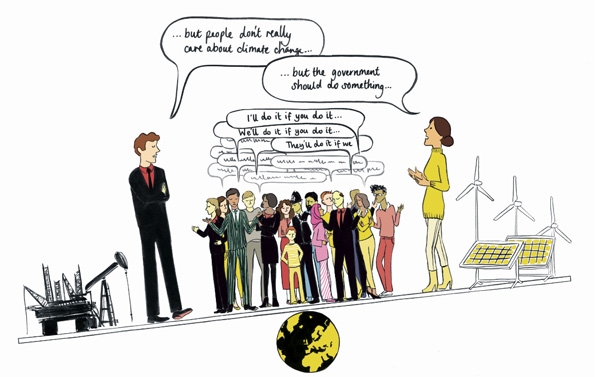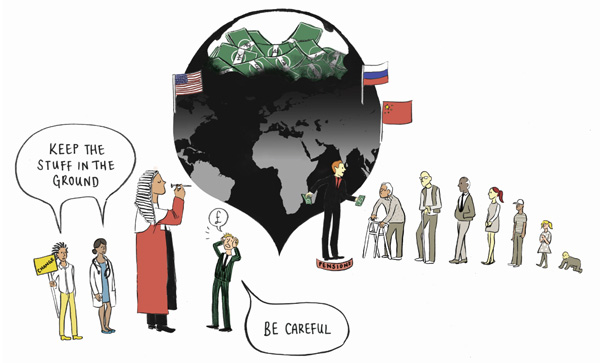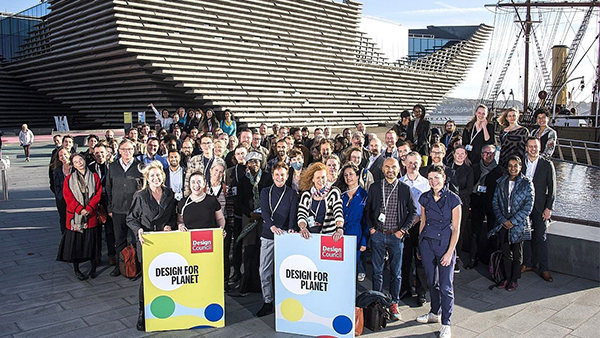Wait, did that really happen? Did almost 200 countries, rich and poor, big and small, agree on something important? Did assembled political leaders decide, on reflection, that perhaps we shouldn’t destroy our only habitat after all?
Judging by the triumphant euphoria coming out of ‘Paris cop21’, it would seem so. We did it!
But what, exactly, did we do?

The Good:
We turned an established but disempowered scientific consensus into a shared global political consensus.
In diplomatic terms, that’s a huge shift in perspective. We have known about global warming- that we were causing it, that it is hazardous and harmful and that we can and should do something about it – for more than half a century. At the first conference of the parties (‘Cop’) in 1995, it could be said that we started to know that we know, but there was lots of equivocation and some dissenting voices. The significance of the 2015 Paris accord is that now we know that we know that we know – there is universal agreement on diagnosis, and a broad convergence of views on prescription.
“This is truly a historic moment,” the United Nations secretary general, Ban Ki-moon, said in an interview. “For the first time, we have a truly universal agreement on climate change, one of the most crucial problems on earth.”
That difference between isolated pockets of conviction and cooperation and universal agreement should mean that political will to take climate change seriously ceases to be equivocal, tentative and contested – with one eye on whether ‘competitor’ countries are following suit. The Paris accord should mean that facing up to climate change is the new default, the new normal; an established part of the international setting not a neglected part of the plot. The first few pages of the agreement reflects this point, with an unpacking of verbs in italics detailing what ‘the parties’ recall, welcome, recognise, acknowledge, emphasise, stress, agree, decide, request, note, reiterate and so forth.
The agreement was an important victory for the United Nations and the somewhat weary and beleaguered principle of multilateral action. The UN spent four years overcoming political inertia and deep divisions between rich and poor countries to put the deal together. Christiana Figueres, the impressively eloquent, diplomatic and determined UN climate chief who guided the talks tweeted: “I used to say: we must, we can, we will. Today we can say we did.”
Beyond knowing that we know that we know, and the morale boost for collective action that perspective brings, some of the details of the agreement are also encouraging. The ambition to keep average global temperatures “well below 2 °C above preindustrial levels and pursuing efforts to limit the temperature increase to 1.5 °C above preindustrial levels” is the shared telos and touchstone of the agreement, which goes well beyond expectations and brings some (but only some) hope to small island states who need the more ambitious target to simply survive (“1.5 to stay alive”). The principle that developed countries have a greater responsibility towards climate mitigation and adaptation is also included.

The Bad:
Unfortunately, the euphoria experienced in Paris was relative to expectations rather than a sense of absolute achievement. We’re still heading for disaster. It’s all there, in classic diplomatic understatement, on page two of the agreement:
“Emphasizing with serious concern the urgent need to address the significant gap between the aggregate effect of Parties’ mitigation pledges in terms of global annual emissions of greenhouse gases by 2020 and aggregate emission pathways consistent with holding the increase in the global average temperature to well below 2 °C above preindustrial levels and pursuing efforts to limit the temperature increase to 1.5 °C above preindustrial levels.”
For those who don’t know climate change well, that paragraph means Paris has not come anywhere close to solving the problem. There is a huge disjunct, dissonance even, between the celebrated aims/targets/goals of 2 or even 1.5 degrees and the existing commitment and probability of 2.7 to 3.7 degrees (if everything goes to current plans- it could go worse). The gloss on this gap is that there is a process of ‘ratcheting up’ commitments, and regular reviews to ensure that the world gradually converges towards the right targets, but a diverse range of commentators, for instance George Monbiot, Professor Mike Hulme and Chris Hope are rightly sceptical about how much this process will achieve in practice.

The Authentically positive:
When success is achieved against the odds, it is important not to be churlish. If we can’t celebrate achievements like the Paris climate agreement, we won’t be able to keep alive the hope we need to keep campaigning. But equally we can’t just be cheerleaders for a settlement that is clearly inadequate.
How then can we remain authentically positive? Many announced triumphantly that the Paris agreement meant the end of the fossil fuel era. While this perhaps should be the case, it is not at all clear that it is. Indeed it looks as though the agreement was written to avoid precisely this explicit conclusion and much of the projections towards two degrees or below depend on negative emissions technologies rather than a transformation in energy supply.
They key then to being authentically positive is to stay focussed, and keep telling it like it is. Gramsci’s overused distinction is a useful near miss at this point; he said we need pessimism of the intellect but optimism of the will, but on climate change we need something altogether different: to get real, by shaping reality.
Billionaire Philanthropist George Soros attributes his wealth to his grasp of reflexivity – an apparently theoretical notion with huge practical relevance whenever thinking participants are involved. The basic cognitive function of thinking is to understand the world in which we live but the participating function seeks to change the situation to our advantage. When the direction of causation is from world to mind, reality is supposed to determine the participants’ views; but when the direction of causation is from the mind to the world, the intentions of the participants have an effect on the world.
This is the sweet spot of climate realism. ‘World to mind’ is what you get when you read projections by the International Energy Agency about continued demand for coal or oil, or read the IPCC forecasts; they evoke optimism and pessimism. ‘Mind to world’ is where the higher quality of realism lies, because there is scope to act in ways that change the conditions of action at scale, whether that’s the presumed climate indifference of your political representative or the plummeting price of solar energy. For example, it is estimated that every time the volume of solar power doubles, the cost reduces by about 20 percent, a phenomenon known as ‘Swanson’s law’. These connections become clearer when you realise climate change is a challenge across dimensions – science, technology, law, money, democracy, culture, behaviour – and that acting in one dimension has a direct bearing on the reality of several others.
Being authentically positive about climate change therefore means being tenaciously and pro–actively ‘realistic’ by acting in ways that contravene conventional accounts of reality. John Ashton captures this spirit in his extraordinary open letter to Bob Van Beurden, The CEO of Shell:
“You and those who agree with you have a monopoly on realism and practicality. You are ‘balanced’ and ‘informed’. Your enemies are ‘naive’ and ‘short sighted’. And you accuse them of wanting ‘a sudden death of fossil fuels’. No phrase in your speech is more revealing. Nobody is asking for this and if they were they would be wasting their time. But the Freudian intensity of your complaint flashes from the text like a bolt of lightning… You seem to be want us to believe that the issue is not how to deal with climate change but how to do so without touching your business model.”
Money is the touchstone of capitalism, and the best way to shape climate reality is to do what you can to help redirect money from fossil fuels towards renewable energy. Divest Invest has grown out of this understanding and the movement is perhaps the most successful social and environmental movement ever, with at least £2.6 trillion already withdrawn from fossil fuels because of it. The movement is often misunderstood as tactical protest, a form of gesture politics, but it is deeply strategic and currently our best hope.
At a cultural level divestment stigmatizes the continued investment in fossil fuels, attempting to remove their social license to operate. At a technological and monetary level it signals to financiers that we are at the beginning of the end of the fossil fuel era, encouraging them to redirect their money towards new forms of research and infrastructure. At a democratic level, divestment challenges the political power of the fossil fuel industry as it manifests in subsidies. At a behavioural level, divestment wakes people up to their unwitting financial complicity in the challenge, and gives them a way of acting that feels commensurate with the global and systemic nature of the problem.
And even if you doubt the strategy, there is a simple matter of logic. There are estimates, assumptions and qualifications at every stage, but the case for divesting from fossil fuels and reinvesting in alternative energy flows from premises to conclusion as a form of deductive reasoning in roughly 10 parts. Full references are given in an RSA report just published: Money Talks: Invest Divest and the battle for climate realism. (Pages 29–31).
1. There is a scientific consensus on anthropogenic global warming, showing a clear relationship between rising carbon dioxide emissions and atmospheric warming.
2. There is an agreed constraint on temperature warming (2°C above pre–industrial levels on average) widely considered to be the upper limit of acceptable risk for maintaining the quality and viability of our habitat.
3. To stay within that limit, there’s a commensurate total global carbon budget (approximately 800bn tonnes) we can’t exceed, and in 2015, we have already used about two–thirds of it.
4. The IPCC estimate that to have a chance of staying within the temperature limit, global carbon dioxide emissions have to peak by roughly 2032 and fall rapidly towards zero before the end of the century.
5. Most carbon dioxide emissions stem from fossil fuel combustion; estimates range from about 78–87 percent of the total.
6. To stay within the remaining budget (approximately 380 tonnes) there have to be stringent constraints on fossil fuel extraction, or sufficiently developed carbon capture and storage (CCS) technology.
7. However, CCS has stunted potential primarily because it lacks efficacy in reducing net emissions (the process uses significant energy, it does not capture all carbon dioxide emissions, and there is a small residual risk of leakage). Compared to other low–carbon power sources it is costly and slow to deploy at any scale. While CCS is factored in to many climate projections, it is reasonable to discount any significant contribution will be made by CCS within the time constraints implicit in the carbon budget.
8. It follows that most existing fossil fuel reserves are overvalued because they cannot be used without contradicting the scientific and political consensus. The best current estimate suggests that from known reserves, to remain within the 2°C limit, we will have to leave 88 percent of available coal, 42 percent of available gas and 33 percent of available oil in the ground.
9. Given global energy demand is likely to rise rather than fall, it also follows that to maintain a functioning economy and society we will need a swift energy transition to decarbonise the world’s economy, which means rapidly developing alternative forms of energy infrastructure with speed and at scale to gradually replace rather than merely supplement fossil fuels.
10. Fossil fuels will remain a necessary part of the world’s energy for some time to come, but we are compelled to make that time period as short as possible. For moral and financial reasons, we therefore need to stop investing in fossil fuels and invest instead in alternative energy.
Whatever the political fallout after Paris, we can remain authentically positive by strengthening and accelerating the decarbonisation process that is already underway. There are of course huge psychological, cultural, moral and democratic factors in play, but Divest Invest is built on the relatively solid premise that finance drives technological change. Without 18th century coal there would have been no 21st century solar and wind. From an engineering perspective, we have what it takes to transform. What remains unclear is whether we can bend the arc of reality fast enough.
Dr Jonathan Rowson is Director of the Social Brain Centre at the RSA. He is the author of Money Talks: Divest Invest and the Battle for Climate Realism. His book, The Seven Dimensions of Climate Change: rethinking the world’s toughest problem, will be published by Palgrave Macmillan in 2016/2017. From 2016, after six wonderful years at the RSA, he will begin a new venture, co-founding his own institute – Perspectiva - which will examine public policy challenges by integrating systems, souls and society; connecting the evolution of the political economy to relationships and the inner world. You can reach him on Twitter @jonathan_rowson
Related articles
-
A design revolution for the climate emergency
Joanna Choukeir
Joanna Choukeir on Design for Planet, the global gathering of designers during COP26, and the changes design must make.
-
3 ways to talk about climate change and Covid-19
Zayn Meghji
People are making the obvious comparison between the pandemic and the world’s biggest crisis – climate change. But how we make that link will shape our response.
-
What can we learn from Fellows in Southeast Asia
Lauren Orso
In March and April 2019, the RSA's global team will be visiting Singapore, Bangkok and Kuala Lumpur on the hunt for social innovations and exploring potential for an action-oriented Fellows network.




Be the first to write a comment
Comments
Please login to post a comment or reply
Don't have an account? Click here to register.